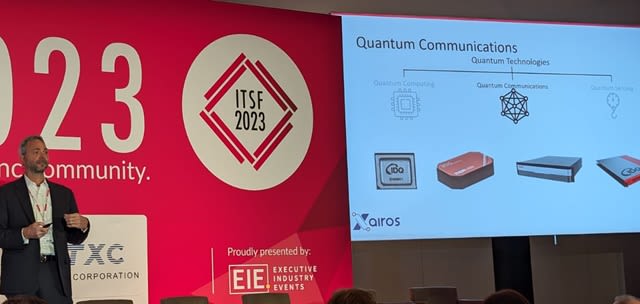
As the World Turns
Did you remember to “fall back” on Sunday?
This antiquated notion of adjusting clocks to accommodate Daylight Savings Time still continues, despite the impacts to people's health and sanity.
We no longer need set our clocks to track seasonal events. Instead, our relationship with time has been altered to accommodate those that really care about it – our electronics.
All networks, financial transactions, communications, and power grids rely on a common time.
In order to efficiently route bits, modern digital networks require incredibly tight synchronization well beyond what is needed by mere humans. In just one nanosecond – one billionth of a second – a 1 GHz processor executes one machine cycle, light travels a foot, and high-speed ethernet delivers 100 bits.
And as these networks move even more data, their timing needs to be ever more precise, stable, and constant. Networks don’t take breaks, or care about daylight savings, leap seconds, or time zones.
Indeed, any slight discontinuity could be disastrous. Case in point: on January 26, 2016, a timing error of only 13 milliseconds nearly caused a global communication meltdown.
So a complex timing infrastructure has emerged that uses a time standard based on atomic transitions (see below), stable clocks, synchronization protocols, and a global time reference provided by GPS.
New technology is enabling these advancements - a celestial reference isn't good enough.
Last Week's Theme: A Modern Horror Story - Part III
- Presented "Quantum Time Transfer" at the International Timing and Sync Forum. Billed as "a who’s who of the timing and sync community," ITSF included presentations by major timing and sync providers and users like BMW, Meta, AMD, BT, Dell, Deutsche Telekom, ESA, and a wide range of power utilities.

- Working hard on proposals! New bids have been submitted working with a range of partners, with more in development.
- Also working on new IP, with a focus on core aspects of our technology and novel system architectures.
- China released an announcement on their plans for future quantum satellites as a follow-on to their groundbreaking Mozi quantum satellite and recent Jinan-1 quantum satellite, the “2030 Quantum Communication and Quantum Computer" project include plans for quantum satellites in LEO, MEO, and GEO orbits to develop "secure communication and key distribution services" and "time-frequency comparisons." In addition they announced plans for "quantum science experimental satellite projects" including "experiments on earth-scale quantum mechanics," "quantum effect testing and gravitational redshift measurement in gravitational fields," "Bell experiments and basic physics tests...in the earth-moon orbit" and "space gravitational wave detection, dark matter detection, quantum gravity detection."
- Not to be outdone, the US National Quantum Initiative Reauthorization Act was introduced with bipartisan support "to accelerate quantum research and development" and boost "competitiveness against China and Russia."
- Slingshot Aerospace has been tracking suspicious activity by a recently launched Russian satellite, "raising fresh concerns about espionage in space."
- It was reported that the Russians installed a GPS jammer to use against Ukraine forces, but had to turn it off so their own forces could use GPS signals. While it was shut off “the Ukrainians blew it up - with a GPS-guided bomb." Ironic.
- As Russia and Ukraine escalate their efforts to "disrupt or spoof GPS signals,” the US military has been re-evaluating their own strategy. “The war in Ukraine has shown how quickly those capabilities — and means of countering them — have evolved," with an official noting that the US Army had "several projects underway to upgrade its electronic-warfare capabilities, and the war in Ukraine had added "urgency" to those efforts."
- While much of the world is enjoying unexpected northern lights, they could be signaling a dangerous increase in solar activity. The National Oceanic and Atmospheric Administration (NOAA) Space Weather Prediction Center (SWPC) issued a watch for a moderate G2-level geomagnetic storm for this weekend following a G3-level geomagnetic storm that hit a few days ago.
"There are only 24 hours in the day" - or are there?
When the Earth was formed, a day was10 hours. Then the moon came along, slowing down the Earth's rotation but also causing minute changes to the rotation rate along the way.
It was medieval timekeepers that divided up a solar day into 24 equal divisions they called hours. But they based it on the time of transit of the sun, which is different than the time it takes for a full Earth rotation - a sidereal day is actually 23.93 hours.
But because the Earth's rotation rate continues to change by a small amount, basing the definition of a second on 86,400 equal divisions of the day means it is also changing!
So in 1967 the definition of the second was instead tied to something more solid - the vibrations of the caesium-133 atom.
For a while scientists attempted to keep this fixed value of seconds synced with the changing rotation of the Earth, occasionally adding leap seconds to Coordinated Universal Time (UTC), the international time standard.
However, in recent years the Earth's rotation has changed course - instead of slowing down, it is speeding up.
Scientists considered subtracting a leap second, but opted instead to scrap the leap second altogether.
This decision was partly at the behest of network operators. As mentioned before, sensitive networks cannot accommodate any time discontinuity, much less a whole second.
That is why GPS time, the de facto time reference for all networks, never incorporated leap seconds. As a result, GPS time and UTC differ by 18 seconds - and likely will never get reconciled.
To learn more, please email us or schedule a meeting here.

